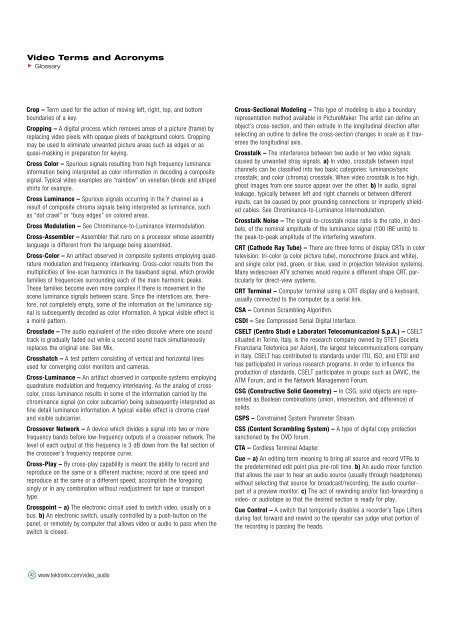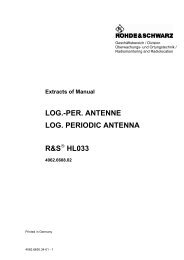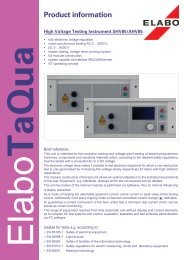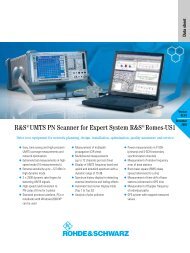Glossary of Video Terms and Acronyms - Isotest
Glossary of Video Terms and Acronyms - Isotest
Glossary of Video Terms and Acronyms - Isotest
Create successful ePaper yourself
Turn your PDF publications into a flip-book with our unique Google optimized e-Paper software.
<strong>Video</strong> <strong>Terms</strong> <strong>and</strong> <strong>Acronyms</strong><br />
<strong>Glossary</strong><br />
Crop – Term used for the action <strong>of</strong> moving left, right, top, <strong>and</strong> bottom<br />
boundaries <strong>of</strong> a key.<br />
Cropping – A digital process which removes areas <strong>of</strong> a picture (frame) by<br />
replacing video pixels with opaque pixels <strong>of</strong> background colors. Cropping<br />
may be used to eliminate unwanted picture areas such as edges or as<br />
quasi-masking in preparation for keying.<br />
Cross Color – Spurious signals resulting from high frequency luminance<br />
information being interpreted as color information in decoding a composite<br />
signal. Typical video examples are “rainbow” on venetian blinds <strong>and</strong> striped<br />
shirts for example.<br />
Cross Luminance – Spurious signals occurring in the Y channel as a<br />
result <strong>of</strong> composite chroma signals being interpreted as luminance, such<br />
as “dot crawl” or “busy edges” on colored areas.<br />
Cross Modulation – See Chrominance-to-Luminance Intermodulation.<br />
Cross-Assembler – Assembler that runs on a processor whose assembly<br />
language is different from the language being assembled.<br />
Cross-Color – An artifact observed in composite systems employing quadrature<br />
modulation <strong>and</strong> frequency interleaving. Cross-color results from the<br />
multiplicities <strong>of</strong> line-scan harmonics in the baseb<strong>and</strong> signal, which provide<br />
families <strong>of</strong> frequencies surrounding each <strong>of</strong> the main harmonic peaks.<br />
These families become even more complex if there is movement in the<br />
scene luminance signals between scans. Since the interstices are, therefore,<br />
not completely empty, some <strong>of</strong> the information on the luminance signal<br />
is subsequently decoded as color information. A typical visible effect is<br />
a moiré pattern.<br />
Crossfade – The audio equivalent <strong>of</strong> the video dissolve where one sound<br />
track is gradually faded out while a second sound track simultaneously<br />
replaces the original one. See Mix.<br />
Crosshatch – A test pattern consisting <strong>of</strong> vertical <strong>and</strong> horizontal lines<br />
used for converging color monitors <strong>and</strong> cameras.<br />
Cross-Luminance – An artifact observed in composite systems employing<br />
quadrature modulation <strong>and</strong> frequency interleaving. As the analog <strong>of</strong> crosscolor,<br />
cross-luminance results in some <strong>of</strong> the information carried by the<br />
chrominance signal (on color subcarrier) being subsequently interpreted as<br />
fine detail luminance information. A typical visible effect is chroma crawl<br />
<strong>and</strong> visible subcarrier.<br />
Crossover Network – A device which divides a signal into two or more<br />
frequency b<strong>and</strong>s before low-frequency outputs <strong>of</strong> a crossover network. The<br />
level <strong>of</strong> each output at this frequency is 3 dB down from the flat section <strong>of</strong><br />
the crossover’s frequency response curve.<br />
Cross-Play – By cross-play capability is meant the ability to record <strong>and</strong><br />
reproduce on the same or a different machine; record at one speed <strong>and</strong><br />
reproduce at the same or a different speed; accomplish the foregoing<br />
singly or in any combination without readjustment for tape or transport<br />
type.<br />
Crosspoint – a) The electronic circuit used to switch video, usually on a<br />
bus. b) An electronic switch, usually controlled by a push-button on the<br />
panel, or remotely by computer that allows video or audio to pass when the<br />
switch is closed.<br />
42 www.tektronix.com/video_audio<br />
Cross-Sectional Modeling – This type <strong>of</strong> modeling is also a boundary<br />
representation method available in PictureMaker. The artist can define an<br />
object’s cross-section, <strong>and</strong> then extrude in the longitudinal direction after<br />
selecting an outline to define the cross-section changes in scale as it traverses<br />
the longitudinal axis.<br />
Crosstalk – The interference between two audio or two video signals<br />
caused by unwanted stray signals. a) In video, crosstalk between input<br />
channels can be classified into two basic categories: luminance/sync<br />
crosstalk; <strong>and</strong> color (chroma) crosstalk. When video crosstalk is too high,<br />
ghost images from one source appear over the other. b) In audio, signal<br />
leakage, typically between left <strong>and</strong> right channels or between different<br />
inputs, can be caused by poor grounding connections or improperly shielded<br />
cables. See Chrominance-to-Luminance Intermodulation.<br />
Crosstalk Noise – The signal-to-crosstalk noise ratio is the ratio, in decibels,<br />
<strong>of</strong> the nominal amplitude <strong>of</strong> the luminance signal (100 IRE units) to<br />
the peak-to-peak amplitude <strong>of</strong> the interfering waveform.<br />
CRT (Cathode Ray Tube) – There are three forms <strong>of</strong> display CRTs in color<br />
television: tri-color (a color picture tube), monochrome (black <strong>and</strong> white),<br />
<strong>and</strong> single color (red, green, or blue, used in projection television systems).<br />
Many widescreen ATV schemes would require a different shape CRT, particularly<br />
for direct-view systems.<br />
CRT Terminal – Computer terminal using a CRT display <strong>and</strong> a keyboard,<br />
usually connected to the computer by a serial link.<br />
CSA – Common Scrambling Algorithm.<br />
CSDI – See Compressed Serial Digital Interface.<br />
CSELT (Centro Studi e Laboratori Telecomunicazioni S.p.A.) – CSELT<br />
situated in Torino, Italy, is the research company owned by STET (Societa<br />
Finanziaria Telefonica per Azioni), the largest telecommunications company<br />
in Italy. CSELT has contributed to st<strong>and</strong>ards under ITU, ISO, <strong>and</strong> ETSI <strong>and</strong><br />
has participated in various research programs. In order to influence the<br />
production <strong>of</strong> st<strong>and</strong>ards, CSELT participates in groups such as DAVIC, the<br />
ATM Forum, <strong>and</strong> in the Network Management Forum.<br />
CSG (Constructive Solid Geometry) – In CSG, solid objects are represented<br />
as Boolean combinations (union, intersection, <strong>and</strong> difference) <strong>of</strong><br />
solids.<br />
CSPS – Constrained System Parameter Stream.<br />
CSS (Content Scrambling System) – A type <strong>of</strong> digital copy protection<br />
sanctioned by the DVD forum.<br />
CTA – Cordless Terminal Adapter.<br />
Cue – a) An editing term meaning to bring all source <strong>and</strong> record VTRs to<br />
the predetermined edit point plus pre-roll time. b) An audio mixer function<br />
that allows the user to hear an audio source (usually through headphones)<br />
without selecting that source for broadcast/recording; the audio counterpart<br />
<strong>of</strong> a preview monitor. c) The act <strong>of</strong> rewinding <strong>and</strong>/or fast-forwarding a<br />
video- or audiotape so that the desired section is ready for play.<br />
Cue Control – A switch that temporarily disables a recorder’s Tape Lifters<br />
during fast forward <strong>and</strong> rewind so the operator can judge what portion <strong>of</strong><br />
the recording is passing the heads.





